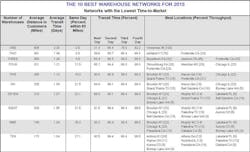If you could have only one warehouse in your national network, then Vincennes, Indiana, would be the best place to locate your facility, as Vincennes tops the list of the ten best warehouse networks, according to a new study from Chicago Consulting.
"Best" is defined as those networks that are closest to the U.S. population and the time it takes to get products to customers.
“It is true,” says Terry Harris, managing partner of Chicago Consulting, “that not all businesses’ customer or sales patterns follow the U.S. population. However, many do. Even many industrial and B2B patterns follow the population. After all end consumers’ purchases account for over 2/3rds of the US economy. It’s hard to think of businesses that do not, at least eventually, relate to the population.”
While this is the 21st year that firm has conducted this survey, this year they added two new statistics to reflect the growing retail trend of same-day delivery. “To respond, we included the percentage of the population that is within 65 miles of their closest warehouse and therefore could likely be served in the same day. Same-day delivery requires high density found in urban centers,” says Harris, “so 65 miles is about the practical limit for its viability.” Also included this year are the percentages of the population that are served in one, two, three and four days by conventional carriers in which deliveries start the day after freight is picked-up.”
The 10 Best Warehouse Networks for 2015 are as follows:( click here for larger image)
Thus if one warehouse were put in any location other than Vincennes, the average distance to the US population would be greater than 806 miles and the average transit lead-time would be greater than 2.28 days. Placing any three warehouses in locations other than Boyertown, PA, Jackson, TN, and Porterville, CA, would result in an average transit lead-time greater than 1.29 days.
Harris points out that time-to-market is not the only criteria for locating warehouses. He says other factors include costs; inbound transportation; labor; ocean, rail, road and air infrastructure; the local carrier market; sustainability; support from economic development organizations; and many others. However, businesses continue to compete on timely responsiveness to their customers. According to Harris, “Amazon is perhaps the best contemporary example. Many others scramble to match them.”




